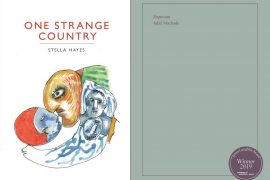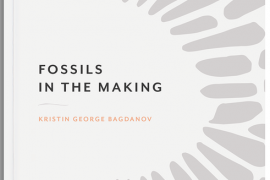WITCH by Rebecca Tamás (Penned in the Margins, 2019)
In her debut collection, WITCH, Rebecca Tamás explores history, language, nature and the body through the lens of “the witch,” in poems that transgress conventional boundaries reaching for a world not wholly understood but painfully, intensely alive.
The opening poem, /penis hex/, casts a multitude of happy ways to “hex a penis off.” From the outset we are told that “the hex for a penis isn’t really all about / the penis” though “when it goes you see you see a lot of things.” Tying this penis to rationalist philosophies, the “logical / summation of things,” Tamás moves outside a phallogocentric culture and, throughout the collection, probes open hierarchical binaries—masculine/feminine, reason/nature, mind/body and presence/absence. Where there is, “some woman in a mint silk pantsuit so happy with / a penis between her legs and the next shucking it off / able to do exactly as is necessary,” the phrasing both underscores that it isn’t the physical penis that is the issue per se and blurs a strict delineation of gender: whose is the penis between the happy woman’s legs? There’s a palpable satisfaction to the verb shuck, calling to mind repetitive, manual “women’s work” with corn or oysters, discarding the parts we can’t use, the sliding in of a knife and the swift flick of a wrist. These excisions suggest a freedom from the phallus that dominates both women’s experience and theory. It’s a liberation that sounds like a hymn: “hex it through glory / total and utter glory.” The linking of curse and magnificence positions the hexing as celebratory affirmation rather than a negative act, and—with the religious connotations of “glory” as the manifestation of god—one flowing from a conception of the divine.
The witch-hunts of early modern Europe anchor us as Tamás’s witch traverses pre-industrial history to the contemporary, “huge cobalt industrial complex eye.” 15-17th century Europe saw land enclosure and the rise of capitalism, colonisation and the start of the Atlantic slave trade, Cartesian philosophy and the Scientific Revolution —alongside the killing of hundreds of thousands of (primarily) women tried for “witchcraft” in what Marxist feminist scholar, Silvia Federici, calls in Caliban and the Witch, “a campaign of terror.” Tamás implicates these historical events in the familiar control of women’s voices and bodies. In the poem WITCH TRIALS, the witch considers “how it started,” gathering ‘maybes’: from abortion, “when someone knocked a fence up,” to “when her friend started to say hit me / please hit me please hit me hit me hit me hit me hit me.” From the kiss sub cauda to the scold’s bridle, the witch-hunt could be almost too direct a metaphor for ongoing misogynistic violence and silencing, but the poems root these in real bodies—like “the witch” herself, always both literal and symbolic. WITCH TRIALS ends with a refusal to look away “even if it took every piece of eye meat / she would develop night vision / for this long night.” The witch bears witness—in sight and word, eye and mouth.
Magic insists that words hold power, and Tamás engages with the transformative force of language. In the poem WITCH SCOLD, the bridled witch asks:
and if a kind of silence was home what vocabulary
could be eaten back could be swallowed new names
in the damp thought-spaces where no noise comes
a loud cry that isn’t the name of a cry but is a cry
Federici hauntingly states that, “we do not have the viewpoint of the victims, for all that remains of their voices are the confessions styled by the inquisitors, usually obtained under torture, and no matter how well we listen … between the cracks in the recorded confessions, we have no way of establishing their authenticity.” This void of direct voice, a forcible removal of (or from) language—and what it might contain—underlies WITCH. As the elimination of “the penis” in /penis hex/ is an opportunity to “see,” and the witch’s testimony emerges from the lacuna of historical victims’ voices, Tamás repeatedly casts absences, cavities and openings as generative sites, undetermined spaces of possibility and action. In spell for change, “little fissures are putting their black hands onto / the earth / an opening / SMASH SMASH SMASH.” Language itself rises from below, and in WITCH VOLCANO, “Witch lies on the volcano / amongst creeping language / red spaces/ash snowflakes / lava says something huge” but free from linear constraint, in a “song without melody.” It’s a shift from a conventional perspective of space as emptiness (and, perhaps too, of woman defined conceptually as non-man: a lack, and bodily as cavity to be filled or stoppered) that troubles easy distinctions between positive and negative, presence and absence.
Tucked between the hexes that bookend the collection are Interrogation (1) and Interrogation (2), notably almost the only places where formal punctuation or the first person “I” appears—at a physical level, this speech is not free. Conventional language is problematized from the start, asking the reader to consider how, if the use of language is policed (literally, in interrogation, and theoretically in how meaning is formed and valued), can we use it to express our subjective realities? In the subsequent absence of punctuation and the lyric “I,” and the strangenesses and shifting chronology of the narrative poems, Tamás seems to ask what might it allow us if we loosen our language from these kind of formal bindings. By putting words to the strange or messy or dark aspects of experience, leaking these out without cleaning them up, the poems affirm these as existent, and celebrate them.
The body of the collection alternates sequences of longer, loosely narrative WITCH poems —characterised by an intensity of sensation where nature is emphatically rendered— and fragmentary spells where language’s express purpose is to call into being new realities. In WITCH AND THE DEVIL, the witch’s relationship with “the devil”—a seductive figure, both “a beautiful man and a beautiful woman”— is told like a folktale, strange and human, where naming is key. The archetypal figures of “the witch” and “the devil,” read over and over, loosen from their conceptual outlines through repetition. Unpunctuated clauses are held in a shifting rhythm by an interplay of repetitions, consonances and assonances —an interconnected language operating on multiple levels at once:
the devil said something in her ear but it
wasn’t words
so I can’t transcribe it but it looked like a body floating on a sea
of grass with the moon pulling that grass backwards and forwards
in tides and with each tug of the moonlight more blue flowers
burst up
out of the soil and stretch their capped mouths and the
body passes over them
in light so strong you could read by it
WITCH offers a permeable world in immanent living colour: green and pink-veined, blue and black and gold. The witch thinks of “unrolling clouds of blue tits / from the cavities between her muscles” and goodness and badness collects, “like pink nauseous liquid in the links between her vertebrae.”
Greta Gaard argues, in Toward a Queer Ecofeminism, that “dominant Western culture’s devaluation of the erotic parallels its devaluations of women and of nature,” and Tamás’s is an erotic language in which filth and glory co-exist. In WITCH AND THE SUFFRAGETTES, the witch knows,
the smell of freedom is the smell of vomit the witch can see
that now
it isn’t lots of clear light pouring in gold fantastic gold
it is vomiting all over yourself and it getting hard in the folds
it is getting your time and they don’t give you anything so
you bleed down your legs thighs sticky
so they smack when you move them at gloss
smell of slaughtered animals the unclean things
is the smell of where you’re going into the sweat
of piss and cold
into the rawness where the inside comes out
These lines echo Anne Carson in The Gender of Sound, who writes: “[W]oman is that creature who puts the inside on the outside. By projections and leakages of all kinds – somatic, vocal, emotional, sexual.” The discomfort these words engender, the folds as much as the vomit, suggest a freedom that lies in embracing the full experience of living-in-the-body, not forcing a sanitised fictional ideal.
Tamás’s erotics is not only bodily but defiantly weird and sexual. WITCH WOOD considers, “what it would be like to / fuck woods”:
it can’t be made romantic branches are entering
different parts of your body
is that right different parts of your body are entering
branches you are shouting loudly and thistles racketing about in
Penetration is mutual, and the language carries an internal subjectivity of sex, of words pushed through the body where linearity breaks apart:
when the summer gets in there inside the pockets of your arms
open sweaty mouth space is being made
that widens and separates more and more and
you look the same but really green hair
you forget the words for assessment criteria for investigation
for intersection for fence for phallus for trunk for
the thing the thing the thing
one solar panel opening eat it up and eat it up
stacked cream layers of light skin just touching the next fine
membrane of skin
the page with a hoof mark a peaking stain
Through intensity to the exquisite point of orgasm, these lines call to mind Helene Cixous’ jouissance —a type of pleasure-suffering through transgressing ordinary limits of sensation— and the “body without end,” a “spacious, singing flesh.”
If /penis hex/ envisions removing the eclipsing phallus, the final poem, \cunt hex\, embraces such opening, in rage and with humour:
you thought there was a conspiracy of women didn’t you you
thought that
yes you’re right of course
we are laughing at your dick just like you assumed
but for completely different reasons
These urgencies extend to “all the cunt workers taut and loosening / all the cunt workers cuntless or heavy,” all who are willing to excise “the bad matter” in a burning that is, fundamentally, rooted in a kind of love
we are all so damaged and imperfect we are all so hurt
know that as I hex you I hug you know that as
you are hexed and the blood is pouring from your head
and groin that it is only because I love
everything that is alive
Expansive and incendiary, this is a love that questions what it is to be really alive, damaged, imperfect and hurting—a love that is willing to do what is necessary to make space for that, for everyone. For all the darkness and violence, it was joy—a swelling sense of transgressing restrictive boundaries, not pleasant but more akin to Zadie Smith’s “strange admixture of terror, pain, and delight”—that WITCH left me with and that prompted me to send a copy to a friend, a single mother in a difficult situation, because I wanted her to share in it, to “say yes five thousand times / (o love).” It’s a joy both of recognition, and of renewal—like the pink tender pang of new skin when a scab is pulled off—one that isn’t painless but sits in feeling, that sees and affirms the act of living where it isn’t perfect, it’s messy and maybe messed-up and doesn’t look like you’re told it’s meant to, but a “small, bright, filthy song” and no less a glory for it.





